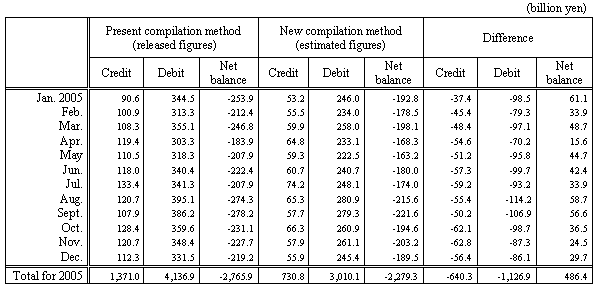Change in the Method for Compiling "Travel" in the Balance of Payments Statistics
July 4, 2006
Ministry of Finance
Bank of Japan
The Ministry of Finance and the Bank of Japan have reviewed the source data and compilation method for "travel" in the balance of payments statistics, a component of services in the current account. The present component approach will be replaced by the expenditure approach to be introduced beginning with revised figures for the January-March quarter of 2006 and preliminary figures for May 2006, both to be released on July 13, 2006.
1. Present Compilation Method (Component Approach)
Japan's present compilation method for "travel"1 focuses on the means of payment used by travelers to pay for goods and services. Specifically, this complex method uses the following source data: international payments/receipts (payments/receipts for package tours and other large-lot payments/receipts); cross-border payments using credit cards; Japanese and foreign currencies used by travelers (estimated from such data as amounts of Japanese and foreign currencies exchanged, amounts of Japanese currency obtained by foreign visitors to Japan prior to their arrival in Japan, and Japanese currency withdrawn from cash dispensers and automatic teller machines in Japan by foreign visitors). These data are combined to estimate the value of goods and services assumed to have been acquired by travelers.2
The present method has the following issues. First, due to the increased diversification of means of payment in recent years, the above-mentioned means of payment are being more frequently used for settlement of transactions that do not fall under "travel."3 Second, expenditures of international students cannot be properly estimated from the present source data.4
- According to the IMF Balance of Payments Manual (fifth edition), a traveler is "an individual staying, for less than one year, in an economy of which he is not a resident," namely, the Japanese economy in the case of foreign visitors, and foreign economies in the case of Japanese travelers abroad. "Travel" covers the goods and services acquired by such travelers in their countries of travel.
- Regarding the present compilation method, refer to the following: "Revision of Compilation Methodology for Balance of Payments Statistics on Travel in Japan," available on the Bank of Japan's web site.
- For example, in recent years, cross-border payments using credit cards have come to include those for goods purchased by individuals staying in Japan from foreign countries via the Internet; such goods should be recorded under "imports" rather than "travel." Similarly, foreign currencies exchanged have come to include those exchanged by residents for investment purposes; such transactions between residents are not included in the balance of payments statistics.
- In accordance with the provisions of the Foreign Exchange and Foreign Trade Law remittances covering tuition and living expenses of international students must be reported to the Bank of Japan when exceeding 30 million yen. These data are available from "reports on payments and receipts." However, because such remittances are normally made in smaller amounts, a large portion of remittances for tuition and living expenses of international students are not fully covered.
2. New Compilation Method (Expenditure Approach)
In fiscal 2005, the Bank of Japan conducted a questionnaire survey concerning travel expenditures (hereinafter referred to as International Travelers' Survey on Expenditures). The survey was conducted at Narita International Airport and Kansai International Airport and covered both foreign travelers visiting Japan and Japanese travelers visiting abroad.5
The results of this survey are used in the new compilation method to directly estimate the amounts spent by travelers to pay for goods and services. Specifically, per capita expenditure amounts of foreign travelers and Japanese travelers obtained from the survey are multiplied by the number of foreign travelers and Japanese travelers (estimated from such data as the number of visitor arrivals and the number of Japanese overseas travelers compiled by the Japan National Tourist Organization, etc.).
Expenditures that cannot be fully reflected in the results of the International Travelers' Survey on Expenditures will be estimated from other source data to be recorded under "travel." For example, the International Travelers' Survey on Expenditures conducted at airports cannot be expected to yield sufficiently accurate data on the expenditures of long-term international students (those staying in Japan or abroad for one year or more).6 Therefore,these expenditures are estimated using data published by government agencies and other organizations on the number of long-term international students and the per capita expenditures of international students (such as tuition and living expenses). Another example concerns foreign travelers and Japanese travelers who are invited as corporate guests and whose travel expenses (such as accommodations and medical expenses) are paid by the host company. Among such expenditures, data on large medical expenses will continue to be obtained from "reports on payments and receipts." These data will be added to expenditures derived from the International Travelers' Survey on Expenditures to estimate total amounts of "travel."
The new compilation method will improve statistical accuracy in the following way.
First, the amounts pertaining to transactions that do not fall under "travel" will be excluded. For example, amounts of cross-border payments using credit cards to settle Internet shopping and amounts of foreign currencies exchanged by residents for investment purposes will be excluded.
Second, the expenditures of international students will be more accurately estimated. The International Travelers' Survey on Expenditures will be used to estimate the expenditures of short-term international students, while data published by government agencies and other organizations will be used to estimate the expenditures of long-term international students.
- 5For an outline of the survey of travelers, refer to "The Outline of Survey Results on Expenditures for Traveling to Japan and Traveling Abroad," available on the Bank of Japan's web site.
- 6Goods and services acquired by international students and medical patients are included in "travel" regardless of the length of their stay.
Reference: Comparison of "Travel" for 2005 Using the Present and New Methods
The estimated figures for 2005 of "travel" using the new method are shown below.

